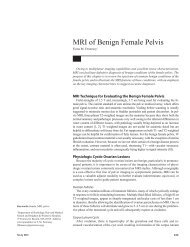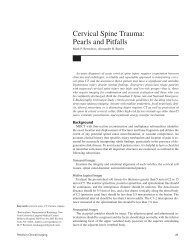Scientific Session 1 â Breast Imaging: Mammography
Scientific Session 1 â Breast Imaging: Mammography
Scientific Session 1 â Breast Imaging: Mammography
Create successful ePaper yourself
Turn your PDF publications into a flip-book with our unique Google optimized e-Paper software.
<strong>Scientific</strong> <strong>Session</strong> 18—Musculoskeletal <strong>Imaging</strong>: Upper ExtremityWednesdayatic spectral MDCT (conventional unenhanced [CU], spectral pancreaticparenchymal, and conventional venous phases) were evaluated.An independent workstation was utilized to assess lesion complexity,scored by two readers in consensus on a 5-point scale for septationsand nodules, first at 78 keV, then at individual-subject-optimized keV(based on contrast-to-noise ratio), and finally with standardized coloredfilter (French).Results: The study population had the following characteristics: 30 female,17 male; mean age, 63 years; mean lesion size, 2.7 cm; availablepathology: 11 intraductal papillary mucinous neoplasms, four serouscystadenomas, three mucinous cystic neoplasms; median optimizedenergy, 51 keV. Compared with viewing at 78 keV (simulating routinePACS viewing of 120 kVp images), more septations were visualized atoptimal keV (14.9% of lesions) and with filter (74.5%); more noduleswere seen at optimal keV (10.6%) and with filter (19.1%). Viewing imageswith optimal keV combined with filter resulted in highest increase invisualization of septations (91.5%) and nodules (25.5%).Conclusion: Greatest lesion complexity was displayed at patientoptimizedkeV combined with colored filter use; depiction of internalstructure and material density with spectral MDCT technique might aidcharacterization of cystic pancreatic lesions. Further correlation with endoscopicultrasound fine-needle aspirate results and resected specimenhistology will be necessary to establish effects on sensitivity, specificity,and prediction of malignancy of cystic pancreatic lesions with dualenergyspectral MDCT analysis.153. MDCT Findings in Incidental Neuroendocrine Tumors of thePancreas and Features Predicting Aggressive BiologyGallotti, A. 1 *; Perez Johnston, R. 2 ; Mino-Kenudson, M. 2 ; Narin, O. 2 ;Fernandez-del Castillo, C. 2 ; Sahani, D. 2 1. University Hospital GBRossi, Verona, Italy; 2. Massachusetts General Hospital, Boston, MAAddress correspondence to A. Gallotti (annagallotti@virgilio.it)Objective: To study MDCT features in incidentally detected pancreaticneuroendocrine tumors (NETs) and to assess if imaging features onMDCT can predict tumor biology.Materials and Methods: A database of patients who had pathological confirmationof pancreatic NETs between June 2005 and November 2009 wasretrospectively reviewed. Of 148 patients, 60 underwent contrast-enhancedMDCT and were included. Location, size, pattern (solid, cystic, or mixed),calcification, ratio of enhancement between tumor and parenchyma, vascularinvasion, dilation of pancreatic duct, peripancreatic lymph node enlargementand liver metastases were assessed. On pathology, lesions weredetermined as nonaggressive if benign and aggressive if malignant or ofuncertain behavior. Sensitivity, specificity, predictive values, and accuracyin the prediction of aggressive biology for the CT findings were calculated.Independent samples t test and regression analysis were applied.Results: Of the 60 NETs (mean size, 33.2 mm), 39 (65%) were located in thebody-tail of the gland. Thirty-eight cases were solid, while cystic changeswere seen in 22 tumors. The solid lesions showed a smaller size than tumorswith cystic changes (p = 0.0017). A total of 28 (47%) were nonaggressiveand 32 (53%) were aggressive at pathology. Nonaggressive tumors mainlypresented as smaller than 2 cm (mean size, 18.0 mm). Aggressive tumorswere larger (mean size, 29.1 mm) (p = 0.0233) and lesions with cystic changeswere mixed. Vascular invasion (n = 16), dilation of the main pancreaticduct (MPD) (n = 8), and enlarged lymph nodes (n = 10) were associated withaggressive tumors. In lesions with cystic changes, the detection of complexpattern had a sensitivity of 78%. Lesions 3 cm or larger in size had specificityand positive predictive value (PPV) of 68% and 61%, which increasedto 100% if solid with calcification, vascular invasion, dilation of MPD orenlarged lymph node. Lesions 2 cm or smaller in size had specificity andpositive predictive value of 75% and 56%, both increased to 100% if solidwith calcification or in lesions with cystic changes.Conclusion: About 50% of incidentally detected NETs show aggressivebehavior. Lesions 3 cm or larger in size or those with cystic changes andcomplex pattern are almost always aggressive. Vascular invasion, dilationof MPD, or peripancreatic lymph node enlargement are related toaggressive behavior. If smaller, a pathological confirmation is necessaryto avoid false-negatives. Early detection is crucial in establishing managementand prognosis.<strong>Scientific</strong> <strong>Session</strong> 18 —Musculoskeletal <strong>Imaging</strong>:Upper ExtremityWednesday, May 4, 2011Abstracts 154-162154. How Often Do Surgeons Intervene on Shoulder Labral LesionsDetected at MR Examination?Magee, T.* NSI, Melbourne, FLAddress correspondence to T. Magee (tmageerad@cfl.rr.com)Objective: We report the prevalence of surgical intervention on shoulderlabral lesions detected at MR examination.Materials and Methods: A retrospective review was made of 100 consecutivepatients who had shoulder labral tears seen on MR examinationwho went to subsequent surgery. Surgical reports were correlated withMR examinations. It was specifically determined whether surgical intervention(i.e., surgical tacking or debridement) was performed on thelesions detected on MR images.Results: Of these 100, 72 had superior labral anterior to posterior (SLAP)tears seen on MR examination, 38 patients had posterior labral tears describedon MR examination, and 28 had anterior labral tears described onMR examination. All 100 patients went on to arthroscopy. All 72 SLAPtears, 38 posterior labral tears, and 28 anterior labral tears shown on MRimaging were also seen on arthroscopy. Of the 72 SLAP tears, 64 weredescribed as fraying on arthroscopy. Of these 64 cases, fourteen were débrided.In 50 cases no surgical intervention was performed. The remainingeight SLAP tears were described as SLAP tears on arthroscopy andsurgical tacking was performed. Of the 38 posterior labral tears, 36 weredescribed as fraying on arthroscopy. Of these 36 patients, seven weredébrided. In 29 cases there was no surgical intervention. Two of the 38had surgical tacking performed arthroscopically. Of the 28 anterior labraltears, 26 had surgical tacking performed. Two of the 28 had their anteriorlabrum débrided arthroscopically.A58*Will present paper
















